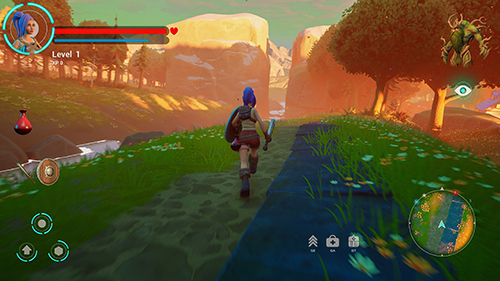In 2018 we launched something new, Michigan’s Best. While it had been around before that this was the first time we focused on the places in Michigan and not just the food. Embarking on this new iteration we understood that the best creation comes from having some guardrails to focus the energy. So, we created three rules:
- We shoot alone, mirroring the influencer, vlog styles that have become the norm now.
- Tell great stories, Michigan is a magical place and it is our job to show people that magic.
- We do not say our names.
Now that last rule might stand out to you as odd but to understand the rule you need to understand something about video games. Like literature, in video games there are first-person and third-person perspective.
 In the first-person perspective, the game is presented from the players point of view, exactly how you see the real world – from your own eyes.
In the first-person perspective, the game is presented from the players point of view, exactly how you see the real world – from your own eyes.
 Third-person, the camera is over the shoulder “following” the player as they navigate the world the game takes place in. When we went about creating that last rule the idea was that we would act as an “avatar” for the viewer allowing them to put themselves in the place or activity we were doing and if we did our job well – they would book a trip to do it themselves.
Third-person, the camera is over the shoulder “following” the player as they navigate the world the game takes place in. When we went about creating that last rule the idea was that we would act as an “avatar” for the viewer allowing them to put themselves in the place or activity we were doing and if we did our job well – they would book a trip to do it themselves.
Doing this for the past six years we have learned our “hunch” was correct, consumers want to put themselves in the video in whatever way they can. So starting your TikTok, Reel, or even YouTube video with “Hey it’s(insert name) and today we are in (insert place)” takes them right out of the content. Because despite our natural leanings towards thinking our digital followers are there for us, they are there because our content makes their lives better by making them laugh, answering a question, or teaching them something and the sooner we get to that for them – the more likely they want another piece of content from us.
Why do perspectives in video matter? They matter because of a technological shift that has been gaining steam over the past twelve months. That technology is augmented reality and the shift is profound for two reasons. The first of which has been called “The Ray Ban moment” which was the idea that consumers are not going to wear a huge headset like Meta Quest, Apple’s Vision Pro, or HTC Vive. No, we need to get to the moment where the technology was innocuous and sat upon a user’s nose and it looked no different that reading or sun glasses.
Google Glass and Snap Spectacles were the first to catch the imagination of consumers and the space got more crowded from there. Microsoft working on HoloLens, Vuzix, and Lenovo all join the fray and Meta, not to miss the point, partnered directly with Ray Ban this year to release the Ray Ban Stories. When you are talking about a new or in this case new(ish) technology there is something known as the innovation curve and you can use to explain any technology from the typewriter to the iPhone, to TikTok. The innovators have been playing in this space for a few years and we are currently in the early adoption phase with most models putting the late majority phase of this tech 5 to 10 years away.

While a decade might seem like a lifetime for your business for some perspective, TikTok did not exist in the United States six years ago, today it is driving most of our culture and certainly the way in which consumers ingest content. Why this matters is perspective, as we move away from consumers viewing content on a phone, tablet, or laptop to seamlessly consuming with augmented “glass wear” the understanding of perspective becomes a competitive advantage. If you start creating content that puts the consumer or viewer at the center using your view of the world as an “avatar” for their view you will be lightyears ahead of your competition when we move away from smartphones.
Because if the trendline holds true these AR lenses are a gateway to the next step which is immersive virtual reality, what some might call the “metaverse” and in that world the consumer is taking it all in from a first-person perspective. Think “Ready Player One” “Neuromancer,” or “Snowcrash,” in movies think “Free Guy,” “Inception” or “Blade Runner.” Whatever your pop culture reference for this, the technology is here right now and will only become more, not less, ubiquitous and like all new technology your adoption rate is directly related to your curiosity and after the year of AI we just had, curiosity is a skill that can absolutely future-proof your business.
WE'RE HERE TO HELP
Grow Your Business
The MLive Media Group of today drives Michigan businesses to greater success. Contact us with any opportunities for us to help you.


 Ad Choices
Ad Choices
